by Peter Robinson
Embarrassingly, I don’t remember the first time I topped 100mph on the road. Almost certainly most of you – at least those of a certain age – recall that milestone occasion with absolute clarity. I asked six AMHF members and all could recall in precise detail the car, the road and the circumstances that led to their achievement.
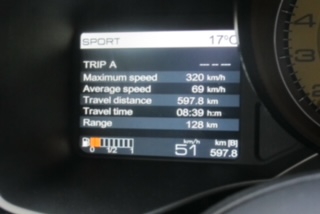
This target probably means nothing to those who became drivers from the 1990s and into the 21st century, when any warm hatchback was capable of The Ton. Besides, by then, we talked in km/h not mph. But back in the 1960s, when a 1275 Mini Cooper S struggled to reach three figures and my Austin Healey Sprite Mk11A strained unsuccessfully to touch 90mph, it was a serious triumph.
I do remember the next landmark. In 1968, a 4.9-litre V8 Ford Falcon XT GT took me to 120mph (193km/h) for the first time on a slightly downhill section of the two-lane Hume Highway near Kalkalo. A few years later, I spent a day attempting to coax a serious V-max out of a Series Two Jag E-Type Coupe. Disappointingly, on the 3.07 final drive ratio it proved capable of just 130mph (209km/h), and that at 5100rpm, 100rpm into the red. This was seriously short of the 150mph Jaguar claimed for the original higher revving 3.8-E-type. Only years later did I learn that the test cars handed out to The Motor and The Autocar magazines were some way beyond standard.
The coming of 140mph Australian supercars – Ford Falcon GT HO, Holden Monaro 327/350 and Chrysler Charger E38/E49 – in those halcyon days before speed limits, when testing maximum speeds was simply a matter of driving just beyond the suburbs of any Australian city and burying the right foot, took performance to another level.
Before I left for Italy in 1988, I’d seen a genuine 160mph (258km/h) in a couple of Italian supercars on Australian roads. That was in the 1970s. By the late 1980s speed cameras, radar and unmarked police cars ensured such socially unacceptable behaviour were essentially impossible, if you wanted to retain your driving licence. Unless you ventured to the wide-open spaces of the big-sky Northern Territory (4600kms from Sydney on sealed roads), the only area in Australia then still uninhibited (the open road speed limit is now 130km/h).
My addiction to speed remained unquenchable and, in Italy, with frequent access to autobahns and autostradas plus increasingly quick cars, my V-Max aspirations quickly escalated to 200mph (322km/h).
On the magical A22, my frequently travelled path north through the Alps from Italy to Austria and Germany to visit BMW and Audi, my initial let’s-obey-the-rules 130km/h cruising speed quickly lifted to 160km/h and, if I was in a hurry, to 200km/h. And still the faster cars – turbocharged Lancia sedans, big BMWs and the occasional Porsche – dashed passed. Thirty-five years ago it took just one long drive to realise that Italy’s 130km/h autostrada speed limit was no more than a guide. I lost count of the number of times I cruised passed a police car at 160km/h, only to be ignored. Not so today with average speed cameras on many of the widespread autostrada.
Returning to Italy in a Porsche 993 Turbo S from three days pretend combat, in Rheims, Spa and the Nordschleife, with a bunch of Viper GTSs, former Ford design boss Moray Callum and I cruised happily between 150-175mph during the early hours of the morning. At 2.00am, roads clear of any traffic, the 444bhp 993 Turbo S reached 180mph, on a downhill section, just shy of its claimed 188mph (302km/h) maximum.
What of the 231mph (372km/h) McLaren F1, still the fastest normally-aspirated car of all time? I didn’t get the chance to explore the very top end of the F1’s performance during my May 1994 drive of the mighty Macca in Yorkshire. However, so blistering was the acceleration – 140-160mph took only 3.4 seconds – that while passengering with one of Autocar magazine’s gun road testers, we did see something close to 215mph and rising on a two-lane road. Doesn’t count for I wasn’t at the wheel.
In June 2003, to confirm the Mercedes-Benz SLR McLaren’s performance credentials – and especially its top speed – Mercedes invited journalist to Spain’s Applus IDIADA proving ground. Here, on the 4.7-mile speed bowl, really two 1.25mile straights connected by long radius banking where the neutral speed in the third lane is 125mph, the 207mph super car could legally and safely be stretched, though we were barred from the top of the four banked lanes. Even so, I did see over 190mph on the bowl, but that’s not the same as being on a road.
I turned down Bugatti’s invitation to attend the October 2005 launch in Sicily. Tempting as the chance to drive the new 407km/h (253mph) Veyron was, all my time was devoted to writing a book on the VE Commodore, so with regrets I said no. To this day I’ve not driven one of VW’s Bugattis. My experience with the 220mph (355km/h) Bugatti EB110 SS, from Romano Artioli’s era, was limited to the little test track around Bugatti’s Campogaliano factory, just north of Modena.
With few exceptions – mostly all Porsches – Germany’s car makers agreed to a voluntary speed limit of 250km/h in 1987 when BMW launched the V12 750i production cars. Some M, AMG and RS models (their makers pointing out they came from separate companies to their parent) ignored the limit and there were occasions on light traffic autobahns, mostly heading east out of Munich, when I saw 180mph plus, but never seriously challenged 200mph.
My first conscious attempt at the Double Ton came in 2004. Returning from a Grand Touring comparison of the Aston Martin DB9, Bentley Continental GT, Mercedes-Benz CL600 and Ferrari 612 on a Sunday, I realised all Italy was at lunch, or so it seemed given the scarcity of traffic. The Ferrari’s astonishing 5.7-litre V12, equally at ease at 2000rpm in top gear as it was at plundering the 7600rpm fuel cutout, 100rpm above the redline and 350rpm beyond peak power, filled me with hope. Running the engine out, to the accompaniment of a growing single-pitch bellow that was both exhaust and top-end engine noise – all those whirring cams and gears – the 612 effortlessly reached 192mph, tacho on the redline, car tracking straight. Close.
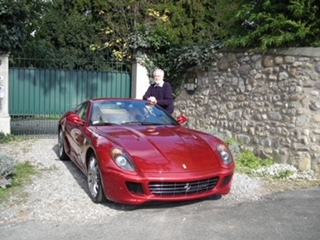
Three years later, again on a Sunday and the same day Kimi Raikkonen took the 2007 World Driver’s championship for Ferrari (another explanation for why there was so little traffic). This time my weapon was a 599 GTB, the 6.0-litre V12 (Tipo F140C) inherited from the Enzo and the replacement for the F133 engine that powered the 612 and so many other Ferrari production models including the 550 and 575s. Until I drove the F12, I rated the 599 GTB Fiorano stupendous, the best car I’d driven: civilised, comfortable, breathtakingly capable, with the world’s best V12 and, above all, both flexible and beyond fast.
The higher revving new V12 produced maximum power of 612bhp (456kW) from 7600rpm to 8400pm. Claimed top speed? 330km/h or 205mph.
South of Cremona there’s a little used 27km link section of autostrada (A21 dir) that connects the A21 (Brescia to Turin) and the always busy A1 (Milan to Rome). It’s essentially straight, with no bends, the surface is smooth, and on this day there was no rain, just a few clouds and plenty of sun, and none of the haze that often limits visibility on the Po Plain. From experience, I knew this was the perfect location for my attempt, for being a Sunday also meant no trucks.
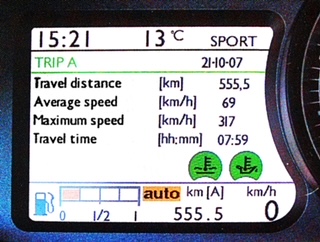
Into fifth at around 140mph (225km/h), the engine pulling to 180mph (290km/h) at the redline before tapping the paddle into sixth. Only above 180mph (305km/h) does the 599’s rate of acceleration tail off. We climbed ever higher, the V12 operating in the 7200-7500rpm range and erupting towards the red, speedo still rising. Both lanes unhindered. Until – travelling at around 85 metres per second – I catch sight of a slow-moving BMW 730i hogging the centre line about a kilometre ahead. Caution takes over. I lift early. Sensible, with a 170km/h closing speed, but apparently unnecessary. If I’d kept my right foot planted for a couple more seconds, I’d have reached 200mph. Instead, the Ferrari’s trip computer readout leaves my maximum speed at 317km/h or 195mph.
Wonderful isn’t it, that Ferrari would create a trip computer that registers the maximum speed achieved on any drive, yet makes no mention of fuel consumption? The trip computers in today’s models at least provide the range, if not the fuel consumption.
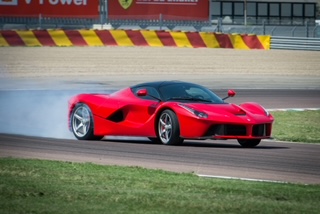
Seven years later I was back in Maranello to test the 708kW(950bhp) mild hybrid LaFerrari on what I knew would be my last official visit to Ferrari. LaFerrari was the latest in Ferrari’s line-up of supercars that began with the F40 (some people claim the 288 GTO holds that honour), trailed by the F50 and Enzo – all cars I’d driven, though none at 200mph – and capable of a claimed 218mph (352km/h). In theory, then, 200mph was entirely feasible. Except, I only barely managed 155mph (250km/h) on Fiorano’s short straight, while Ferrari’s challenging road route through the mountains to the south of Maranello wasn’t an appropriate location, despite the car’s ferocious acceleration – 0-200km/h in 6.9seconds.
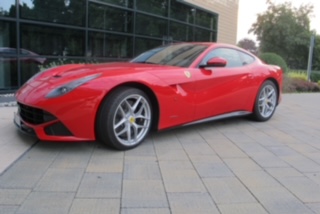
Still, all was not lost, there was an alternative. The factory press office generously lent me an F12 for the weekend. From the moment I drove out the famous gates in the 6.3-litre, 544kW (730bhp) V12 F12, mine for three days, on that May Friday afternoon in 2014, I knew this was my last chance to crack the elusive 200mph (322km/h) on the road.
My plan was simple: I’d depart at sparrow’s on Monday morning, after a weekend visiting friends in Brescia, returning the F12 via the same A21 (dir) autostrada used for the 599 attempt.
The epic F12, a logical development of the 599, brings more power from the still naturally aspirated V12, greater refinement and comfort, a perfect driving position, and brilliant responses. So savage is the performance (10.6seconds for the standing 400metres) that, despite electronic intervention and 52percent of the weight over the back wheels, the F12 breaks traction in the lower gears to the point where you begin to ask if it’s simply too powerful for the road.
The Ferrari sits in the outside lane at 150mph as I enter the chosen autostrada. I’m horrified that there’s a procession of trucks on my right. Bloody Monday morning. Still, they know the rules: no trucks in the outside lane. The soundtrack bellows, fifth tops out at 155mph (251km/h) the tacho needle just beyond the 8250rpm point of peak power, the roar from the exhaust pipes is loud. And the sound of wind.
There’s a break in the line of trucks. Come on boy, keep at it. Sixth takes us to over 190mph (306km/h), into seventh via the right hand paddle. Stability is fantastic (all that downforce), no wandering, no lateral movement, just a super-fast approaching horizon, the digital speedo climbs 315…316…317…318…319… and finally 320.
More trucks, and a car. In the fast lane. That’s enough. I know 320 km/h is not quite 200mph, but I’m not precisely sure how close it is…suddenly we’re at the A1 and heavy traffic, even at 6.00am. That’s it. Time to ease back to a gentle 200km/h. I do some sums.
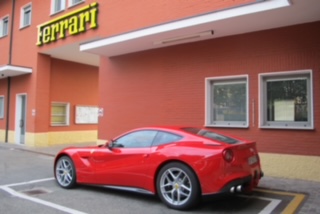
I can’t tell you what it’s like to drive the Ferrari F12 at 200mph, but I can comment on what it’s like at 199mph. That’s the rounded up number: 320km/h equals 198.7mph. So close, but a failure. And there’s no next time.

